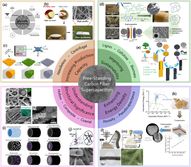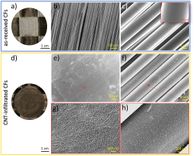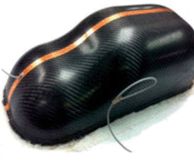Highlights
This is a selection of publications from the Structural Power Composites Group. For a full list of publications, please see below.
Results
- Showing results for:
- Reset all filters
Search results
-
Journal articleNguyen S, Anthony DB, Katafiasz T, et al., 2024,
Manufacture and characterisation of a structural supercapacitor demonstrator
, Composites Science and Technology, Vol: 245, ISSN: 0266-3538Structural power composites, a class of multifunctional materials, may facilitate lightweighting and accelerate widespread electrification of sustainable transportation. In the example considered in this paper, structural power composite fuselage components could provide power to open aircraft doors in an emergency and thus reduce or eliminate the mass and volume needed for supercapacitors currently mounted on the doors. To demonstrate this concept, an 80 cm long multifunctional composite C-section beam was designed and manufactured, which powered the opening and closing of a desktop-scale composite aircraft door. Twelve structural supercapacitor cells were made, each 30 cm × 15 cm × 0.5 mm, and two stacks of four cells were integrated into the web of the beam by interleaving and encasing them with low-temperature-cure woven carbon fibre/epoxy prepreg. This article culminates by considering the engineering challenges that need to be addressed to realise structural power composite components, particularly in an aerospace context.
-
Journal articleValkova M, Nguyen S, Senokos E, et al., 2023,
Current collector design strategies: The route to realising scale-up of structural power composites
, Composites Science and Technology, Vol: 236, Pages: 1-9, ISSN: 0266-3538Multifunctional structural power composites, which combine mechanical load-bearing and electrochemical energy storage, will transform electric vehicle design. This work focuses on structural supercapacitors, based on carbon aerogel-modified carbon fibre electrodes with copper current collectors. In common with many structural power embodiments, scale-up of these devices is currently limited by large internal resistances and the mass associated with current collection. There is a trade-off between the overall resistive power loss and the additional mass for the current collector material. However, in these devices, mechanical integrity is provided by the structural electrodes, allowing a range of collector designs to be considered. Using finite element simulations, these current collection strategies are explored quantitatively across a range of design space variables. The key conductivity parameters were measured experimentally, using the best existing materials, to inform direct current conduction simulations of the electrode/current collector assembly. For the present device configuration, the performance trade-off is governed by the area of the current collector. The most effective near-term strategy for power loss mitigation lies in reducing the contact resistance; however, improvements can also be obtained by modifying the collector geometry. The findings of this paper can be generalised to other structural power composites and monofunctional energy storage devices, which are relevant in many mass-sensitive electrochemical applications.
-
Journal articleSenokos E, Anthony DB, Rubio N, et al., 2023,
Robust single‐walled carbon nanotube‐infiltrated carbon fiber electrodes for structural supercapacitors: from reductive dissolution to high performance devices
, Advanced Functional Materials, Vol: 33, Pages: 1-11, ISSN: 1616-301XMultifunctional electrodes for structural supercapacitors are prepared by vacuum infiltration of single-walled carbon nanotubes (SWCNTs) into woven carbon fibers (CFs); the use of reductive charging chemistry to form nanotubide solutions ensured a high degree of individualization. The route is highly versatile, as shown by comparing four different commercial nanotube feedstocks. In film form, the pure nanotubide networks (“buckypapers”) are highly conductive (up to 2000 S cm−1) with high surface area (>1000 m2 g−1) and great electrochemical performance (capacitance of 101 F g−1, energy density of 27.5 Wh kg−1 and power density of 135 kW kg−1). Uniformly integrating these SWCNT networks throughout the CF fabrics significantly increased electrical conductivity (up to 318 S cm−1), surface area (up to 196 m2 g−1), and in-plane shear properties, all simultaneously. The CNT-infiltrated CFs electrodes exhibited intrinsically high specific energy (2.6–4.2 Wh kg−1) and power (6.0–8.7 kW kg−1) densities in pure 1-ethyl-3-methylimidazolium bis(trifluoromethylsulfonyl)imide (EMIM TFSI) electrolyte. Multifunctional structural supercapacitors based on CNT-coated CFs offer a substantial increase in capacitive performance while maintaining the tensile mechanical properties of the as-received CF-based composite. This non-damaging approach to modify CFs with highly graphitic, high surface area nanocarbons provides a new route to structural energy storage systems.
-
Journal articleGreenhalgh ES, Nguyen S, Valkova M, et al., 2023,
A critical review of structural supercapacitors and outlook on future research challenges
, Composites Science and Technology, Vol: 235, Pages: 1-19, ISSN: 0266-3538Structural composites and electrochemical energy storage underpin electrification of transportation, but advances in electric vehicles are shackled by parasitic battery mass. The emergence of structural power composites, multifunctional materials that simultaneously carry structural loads whilst storing electrical energy, promises dramatic improvements in effective performance Here, we assess the literature on structural supercapacitors, not only providing a comprehensive and critical review of the constituent (i.e., structural electrode, structural electrolyte and structural separator) developments, but also considering manufacture, characterisation, scale-up, modelling and design/demonstration. We provide a rigorous analysis of the multifunctional performance data reported in the literature, providing the reader with a detailed comparison between the different structural supercapacitor developments. We conclude with insights into the future research and adoption challenges for structural supercapacitors. There are several significant hurdles which must be addressed to mature this technology. These include development of a processable structural electrolyte; optimisation of current collection to facilitate device scale-up; identification of load-transmitting encapsulation solutions; standard protocols for characterisation and ranking of structural supercapacitors and; predictive multiphysics models for structural supercapacitors. Through addressing such issues, these emerging multifunctional materials will deliver a novel lightweighting strategy that can contribute to managing the ongoing climate crisis.
-
Journal articleAnthony DB, Nguyen SN, Qian H, et al., 2023,
Silica aerogel infused hierarchical glass fiber polymer composites
, Composites Communications, Vol: 39, Pages: 1-7, ISSN: 2452-2139Hierarchical systems can address the matrix-dominated failures of structural fiber polymer composites. Here, a new synergistic hierarchical structure combines conventional structural glass fibers with a bi-continuous silica-based aerogel matrix; both pure-silica and organically-modified silicate aerogels are demonstrated. When infused with an epoxy matrix, this type of hierarchical architecture showed a marked improvement in mechanical properties: without any loss in modulus, both the compressive strength and the interlaminar shear strength increased by up to 27%, relative to the equivalent glass-fiber reinforced epoxy composite baseline. The bi-continuous network modification strategy uses industrially-relevant infusion techniques, at or near room temperature, and retains a similar final composite density (within 2%). The strategy presented here provides a versatile and readily applicable means to improve state-of-the art continuous fiber reinforced composite systems in compression and offers an opportunity to develop a new generation of composite materials.
-
Conference paperAlmousa H, De Luca H, Anthony D, et al., 2023,
Robust continuous production of carbon nanotube-grafted structural fibres: a route to hierarchical fibre reinforced composites
, ECCM20 - The 20th European Conference on Composite Materials, Publisher: Composite Construction Laboratory (CCLab), Pages: 1451-1456Growth of carbon nanotubes (CNTs) onto the fibre surface by direct chemical vapour deposition (CVD) offers a convenient means to integrate synthesis with assembly. This method delivers the nanostructures where they have the greatest influence on fibre-matrix interface or interphase. However, CVD is usually limited to small batches of short fibre lengths, and can damage the primary properties. Here, we describe a robust process to produce carbon nanotube-grafted-fibres continuously at tow level with a uniform coverage of short (sub-500 nm length), 10-20 nm diameter CNTs. Different CNT growth conditions, such as temperature [650-950 °C], duration [0.72-50 min], line speed [0.6-10 m/h], potential difference [0-1000 V], and reactive gas flow/compositions were investigated. Following optimisation, the fabrication of an entirely “fuzzy” fibre reinforced hierarchical composite was achieved.
-
Journal articleLatham KG, Edathil AA, Rezaei B, et al., 2022,
Challenges and opportunities in free-standing supercapacitors research
, APL Materials, Vol: 10, Pages: 1-14, ISSN: 2166-532XThe design of commercial supercapacitors has remained largely unchanged since the 1970s, comprising powdered electrodes housed in rigid metal cylinders or pouches. To power the next generation of integrated technologies, an evolution in supercapacitor materials and design is needed to create multifunctional materials that allow energy storage while imparting additional material properties (e.g., flexibility and strength). Conductive free-standing electrodes produced from fibers or 3D printed materials offer this opportunity as their intrinsic mechanical properties can be transferred to the supercapacitor. Additionally, their conductive nature allows for the removal of binders, conductive agents, and current collectors from the supercapacitor devices, lowering their economic and environmental cost. In this Perspective, we summarize the recent progress on free-standing supercapacitors from new methods to create free-standing electrodes to novel applications for these devices, together with a detailed discussion and analysis on their electrochemical performance and physicochemical and mechanical properties. Furthermore, the potential directions and prospects of future research in developing free-standing supercapacitors are proposed.
-
Journal articleIshfaq A, Nguyen S, Greenhalgh ES, et al., 2022,
Multifunctional design, feasibility and requirements for structural power composites in future electric air taxis
, Journal of Composite Materials, Vol: 57, Pages: 817-828, ISSN: 0021-9983This study investigates the viability of implementing multifunctional structural power composites in a four-seater air taxi, the CityAirbus. For a given specific energy of the power source, the cruise endurance can be approximately doubled by using structural power composites as opposed to conventional batteries. Replacing all the eligible composite mass and batteries with structural power composites can reduce the CityAirbus weight by 25%. To achieve the current design performance, the minimum required elastic modulus, strength, specific energy and power for the structural power composite are 54 GPa, 203 MPa, 74 Wh/kg and 376 W/kg, respectively: current state-of-the-art structural power composites are now approaching this level of performance. Hence, structural power composites are considered feasible for adoption in the urban air mobility sector and have the potential to improve endurance and facilitate commercialization. This paper also discusses several key challenges that must be addressed to realize the adoption of structural power composites in future electric air taxis.
-
Conference paperAnthony DB, Greenhalgh ES, Katafiasz T, et al., 2022,
Structural supercapacitor composite technology demonstrator
, 20th European Conference on Composite Materials, Publisher: SAGE Publications, Pages: 253-259, ISSN: 0021-9983Structural power composites, a class of multifunctional materials, have significantpotential to facilitate lightweighting and accelerate widespread electrification in sustainabletransportation. In civil aircraft, a bank of supercapacitors can provide power to open the doorsin an emergency. Structural power composite fuselage components near the doors could providethis power and eliminate the mass and volume needed for the supercapacitors. To demonstratethis concept, we designed and manufactured a multifunctional component representative of afuselage rib, which powered the opening and closing of a desktop scale composite aircraft door.This paper provides information about structural supercapacitor technology demonstrators,discusses the fabrication of this demonstrator and concludes by providing an insight into thefuture challenges that need to be addressed to realise structural power composite components.
-
Journal articleValkova M, Anthony DB, Kucernak ARJ, et al., 2022,
Predicting the mechanical behaviour of structural supercapacitor composites
, Composites Part A: Applied Science and Manufacturing, Vol: 156, ISSN: 1359-835XMultifunctional structural power composites may transform transport electrification, and other applications, but require performance and reliability improvements. Computational modelling has the potential to accelerate their development and deployment. This work addresses the lack of predictive models for the mechanical behaviour of structural supercapacitor composites exploiting carbon aerogel-modified carbon fabric electrodes. The elastic behaviour was investigated using finite element analysis of quasi-meso-scale periodic unit cell models, considering the effects of constituent properties, defects, stacking geometry, and boundary conditions. Nanoindentation was used to evaluate the Young’s modulus of carbon aerogel. Parametric modelling demonstrated a strong influence of the ply offset and matrix materials on the composite elastic properties. The initial numerical results overpredicted the actual performance measured from tensile and in-plane shear experiments in the literature. Optical, scanning electron and micro X-ray imaging revealed extensive pre-cracking and voidage in the physical laminates. Additional computational investigations showed that the pre-cracks were associated with a degradation of shear stiffness. The remaining performance gap was attributed to voidage. The present study highlights that challenges for mechanical performance and its prediction stem from the presence of processing defects and a lack of in-situ material data. Nevertheless, the models identify the potential of hierarchical laminates containing aerogels to generate sizable performance improvements, both in multifunctional and purely structural contexts.
-
Journal articlePernice MF, Qi G, Senokos E, et al., 2022,
Mechanical, electrochemical and multifunctional performance of a CFRP/carbon aerogel structural supercapacitor and its corresponding monofunctional equivalents
, Multifunctional Material, Vol: 5 -
Journal articleKaradotcheva E, Nguyen SN, Greenhalgh ES, et al., 2021,
Structural power performance targets for future electric aircraft
, Energies, Vol: 14, ISSN: 1996-1073The development of commercial aviation is being driven by the need to improve efficiency and thereby lower emissions. All-electric aircraft present a route to eliminating direct fuel burning emissions, but their development is stifled by the limitations of current battery energy and power densities. Multifunctional structural power composites, which combine load-bearing and energy-storing functions, offer an alternative to higher-energy-density batteries and will potentially enable lighter and safer electric aircraft. This study investigated the feasibility of integrating structural power composites into future electric aircraft and assessed the impact on emissions. Using the Airbus A320 as a platform, three different electric aircraft configurations were designed conceptually, incorporating structural power composites, slender wings and distributed propulsion. The specific energy and power required for the structural power composites were estimated by determining the aircraft mission performance requirements and weight. Compared to a conventional A320, a parallel hybrid-electric A320 with structural power composites >200 Wh/kg could potentially increase fuel efficiency by 15% for a 1500 km mission. For an all-electric A320, structural power composites >400 Wh/kg could halve the specific energy or mass of batteries needed to power a 1000 km flight.
-
Journal articleQi G, Nguyen S, Anthony DB, et al., 2021,
The influence of fabrication parameters on the electrochemical performance of multifunctional structural supercapacitors
, Multifunctional Materials, Vol: 4, ISSN: 2399-7532Multifunctional structural supercapacitors based on carbon fibre electrodes (CF) and structural electrolytes (SEs) can realise multifunctionality by simultaneously bearing load and providing electrochemical energy storage. Structural supercapacitor constituents (i.e. electrodes and electrolytes) have undergone significant development to enhance their electrochemical and mechanical properties. However, the fabrication of fully functional devices presents a number of practical challenges to achieve optimal multifunctional properties, particularly those associated with assembly and lamination. This work investigated the effect of separator selection and processing parameters on the electrochemical performance of structural supercapacitors, as well as evaluating the repeatability of the SE filming process. Two layers of glass fibre fabrics were the most effective separator for preventing short-circuiting of the structural supercapacitors. The weight fraction of the SE matrix had a significant effect on the capacitance, energy and power of the structural supercapacitors. By addressing such fabrication challenges, high performance structural supercapacitors can be manufactured with greater reproducibility and at larger scales such that they are suitable for integration in industrial applications.
-
Journal articleNguyen S, Millereux A, Pouyat A, et al., 2021,
Conceptual multifunctional design, feasibility and requirements for structural power in aircraft cabins
, Journal of Aircraft: devoted to aeronautical science and technology, Vol: 58, Pages: 677-687, ISSN: 0021-8669This paper presents a theoretical investigation into the potential use of structural power composites in regional aircraft passenger cabins and the corresponding challenges to widespread use, including fire-resistance, long-term cycling performance, and cost. This study focusses on adapting sandwich floor panels with structural power composite face sheets, designed to power the in-flight entertainment system. Using a simple mechanical model to define the structural requirements, based on state-of-the-art laminated structural power composites, a series of electrochemical energy storage performance targets were calculated: a specific energy > 144 Wh/kg, a specific power > 0.29 kW/kg, an in-plane elastic modulus > 28 GPa and in-plane tensile and compressive strengths > 219 MPa. Significantly, the use of a distributed energy storage system offered a significant range of other mass and cost savings, associated with a simplified power system, and the use of ground-generated electrical energy. For an Airbus A220-100, the analysis predicted potential mass and volume savings of approximately 260 kg and 510 land annual reductions in CO2and NOx emissions of approximately 280 tonnes and 1.2 tonnes respectively. This extended design analysis of a specific component highlights both the far-reaching implications of implementing structural power materials and the potential extensive systemic benefits.
-
Journal articleLee C, Greenhalgh E, Shaffer M, et al., 2020,
Optimized microstructures for multifunctional structural electrolytes
, Multifunctional Materials, Vol: 2, ISSN: 2399-7532Multifunctional structural materials offer compelling opportunities to realize highly efficient products. However, the need to fulfil disparate functions generates intrinsically conflicting physical property demands. One attractive strategy is to form a bi-continuous architecture of two disparate phases, each addressing a distinct physical property. For example, structural polymer electrolytes combine rigid and ion-conducting phases to deliver the required mechanical and electrochemical performance. Here, we present a general methodology, based on topology optimization, to identify optimal microstructures for particular design considerations. The numerical predictions have been successfully validated by experiments using 3D printed specimens. These architectures are directly relevant to multifunctional structural composites whilst the methodology can easily be extended to identify optimal microstructural designs for other multifunctional material embodiments.
-
Conference paperNguyen S, Millereux A, Pouyat A, et al., 2020,
Structural power performance requirements for future aircraft integration
, 22nd International Conference on Composite Materials 2019 (ICCM22), Publisher: Engineers Australia, Pages: 1-12This paper investigates the use of structural power composites in Airbus A220-100 aircraft cabins by integrating floor panels with face sheets made of structural power composites to power the in-flight entertainment system. This application requires a minimum specific energy of 305 Wh/kg and a minimum specific power of 0.610 kW/kg. The static and dynamic loads for which the floor panels must be certified require an in-plane Young’s modulus of 50 GPa, a compressive strength of 225 MPa and a tensile strength of 119 MPa. Structural power composite floor panels are predicted to yield mass savings of 324 kg, annual cost savings of £85,000 per aircraft and annual reductions in CO2 and NOx emissions of 343 tonnes and 1.4 tonnes respectively. However, addressing challenges such as fire-resistance, long term cycling performance and public perception of structural power composites are necessary to enable widespread use of such materials on-board airliners.
-
Conference paperSenokos E, Anthony D, Nguyen S, et al., 2020,
Manganese dioxide decorated carbon aerogel/carbon fibre composite as a promising electrode for structural supercapacitors
, 22nd International Conference on Composite Materials 2019 (ICCM22), Publisher: Engineers Australia, Pages: 1-8Manganese dioxide electrochemically deposited onto carbon aerogel/carbon fibres (CAG/CF) shows a great potential as an electrode material in multifunctional structural supercapacitors. MnO₂ nanowires grown by a pulse potentiometric method provide a large enhancement in capacitive performance of the carbon electrodes and symmetric supercapacitor devices based on the hybrid material.
-
Journal articleJohannisson W, Nguyen S, Lindbergh G, et al., 2020,
A residual performance methodology to evaluate multifunctional systems
, Multifunctional Materials, Vol: 3, Pages: 025002-025002<jats:title>Abstract</jats:title> <jats:p>The development of multifunctional materials and structures is receiving increasing interest for many applications and industries; it is a promising way to increase system-wide efficiency and improve the ability to meet environmental targets. However, quantifying the advantages of a multifunctional solution over monofunctional systems can be challenging. One approach is to calculate a reduction in mass, volume or other penalty function. Another approach is to use a multifunctional efficiency metric. However, either approach can lead to results that are unfamiliar or difficult to interpret and implement for an audience without a multifunctional materials or structures background.</jats:p> <jats:p>Instead, we introduce a comparative metric for multifunctional materials that correlates with familiar design parameters for monofunctional materials. This metric allows the potential benefits of the multifunctional system to be understood easily without needing a holistic viewpoint. The analysis is applied to two different examples of multifunctional systems; a structural battery and a structural supercapacitor, demonstrating the methodology and its potential for state-of-the-art structural power materials to offer a weight saving over conventional systems. This metric offers a new way to communicate research on structural power which could help identify and prioritise future research.</jats:p>
-
Journal articleValkova M, Anthony DB, Kucernak ARJ, et al., 2020,
Predicting the compaction of hybrid multilayer woven composite reinforcement stacks
, Composites Part A: Applied Science and Manufacturing, Vol: 133, ISSN: 1359-835XA meso-scale finite element modelling strategy was developed to investigate the effect of hybridisation on the compaction response of multilayer stacks combining glass and carbon dry woven fabrics. It is expected that the electrochemical-mechanical properties of emerging multifunctional hybrid composites are strongly dictated by the morphology of the compacted reinforcements, yet no investigations into their compressibility have been reported. Model predictions were evaluated against compressibility measurements for monolithic and hybrid fabric stacks. The ply offset had a major influence on the predicted internal morphologies and fibre content, contributing to experimental variability thereof. Optical microscopy and micro X-ray computed tomography imaging indicated greater likelihood of intermediate ply offsets in physical specimens, over limit case model idealisations. Compressibility was slightly reduced in the hybrid multilayer stacks studied in this work. The model outputs presented are being used to analyse the electrochemical-mechanical response of hybrid woven structural power composites.
-
Journal articleNguyen S, Anthony DB, Qian H, et al., 2019,
Mechanical and physical performance of carbon aerogel reinforced carbon fibre hierarchical composites
, Composites Science and Technology, Vol: 182, ISSN: 0266-3538Carbon aerogel (CAG) is a potential hierarchical reinforcement to improve the matrix-dominated mechanical properties of continuous carbon fibre reinforced polymer (CFRP) composites in both multifunctional and purely structural applications. When using CAG to reinforce a polyethylene glycol diglycidyl ether (PEGDGE) matrix, the interlaminar shear strength, compressive modulus and strength increased approximately four-fold, whilst the out-of-plane electrical conductivity increased by 118%. These mechanical and electrical performance enhancements significantly improve the multifunctional efficiency of composite structural supercapacitors, which can offer weight savings in transport and other applications. However, CAG also has the potential to reinforce conventional continuous CF composites in purely structural contexts. Here, CAG reinforcement of structural epoxy resin composites marginally increased compressive (1.4%) and tensile (2.7%) moduli respectively, but considerably reduced compressive, tensile and interlaminar shear strengths. Fractographic analysis shows that the reduced performance can be attributed to poor interfacial adhesion; in the future, alternative processing routes may resolve these issues to achieve advances in both moduli and strengths over conventional structural CFRPs.
This data is extracted from the Web of Science and reproduced under a licence from Thomson Reuters. You may not copy or re-distribute this data in whole or in part without the written consent of the Science business of Thomson Reuters.
Related links
Contact
Professor Emile S Greenhalgh
Department of Aeronautics
Imperial College London
South Kensington Campus
London SW7 2AZ
+44 (0)7958 210 089
e.greenhalgh@imperial.ac.uk






